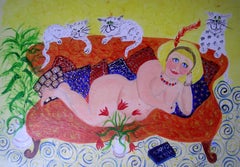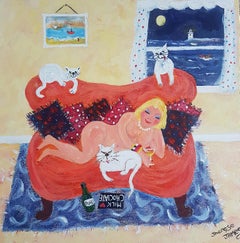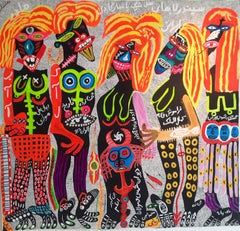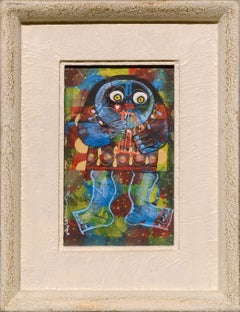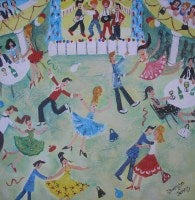Therese James Portrait Paintings
Welsh, b. 1959
We are pleased to sell works on behalf of Therese James. Therese is a full time artist painting and exhibiting since 1993. As a member of the Naive School she works from a compulsion to recreate what she feels and sees. As a self taught naive she relies purely on an instinctive approach to her art and has developed her own style with expressive characters who inhabit the world of her paintings. Therese gets much of her inspiration from the places and literature of her native Wales and the West Country of England. She says she paints the way she paints because she doesn’t know “the rules” and her paintings are a journey of discovery.
More recently she has been inspired to use her painterly skills to create wild and untamed responses to nature, creating semi abstracted, almost primal, sea and landscapes reflecting the raw untrained, instinctive way in which she works.
Therese is very well collected with her works in collections in N. America, Europe, Australasia and Asia.to
1
1
Overall Width
to
Overall Height
to
2
1
1
1
1
1
1
1
1
1
1
1
1
54
280
83
78
76
2
Artist: Therese James
Say Chocolate: Contemporary Mixed Media Figurative Painting
By Therese James
Located in Brecon, Powys
" Say Chocolate" 'part of a series of 'Calendar Ladies'. A departure from the works we generally associate with Therese. Great " Wall Candy" from this very talented Welsh artist.
Pe...
Category
21st Century and Contemporary Outsider Art Therese James Portrait Paintings
Materials
Acrylic Polymer
Perfect Moment
By Therese James
Located in Brecon, Powys
Acrylic on canvas. Signed. Ready to hang
Category
2010s Outsider Art Therese James Portrait Paintings
Materials
Canvas, Acrylic
Related Items
The Lovers Mohammad Ariyaei 21st Century art Iranian painting outsider art
By Mohammad Ariyaei
Located in Paris, FR
Acrylic paint on canvas
Hand-signed low in the center
« Here the barbaric or savage ceremonies of New Guinea take on the air of Rio carnival.
Here the vita...
Category
2010s Outsider Art Therese James Portrait Paintings
Materials
Canvas, Acrylic
$11,181
H 65.75 in W 68.9 in D 1.97 in
Filipina Girl Playing the Harp
Located in Soquel, CA
Vibrant portrait of a Filipino girl playing a harp by an unknown artist (20th Century). This piece is done in the style of traditional Filipino art, with ...
Category
1970s Outsider Art Therese James Portrait Paintings
Materials
Canvas, Acrylic, Wood Panel
Girl with Cat
Located in Washington, DC
Painting by Noche Crist (1909 - 2004). Work is untitled and signed. Measures 22" x 12".
Painting is casein paint and plaster on board.
Catalogue of an exhibition in 2008 at the...
Category
1960s Outsider Art Therese James Portrait Paintings
Materials
Acrylic
Outsider Folk Art Expressionist Rabbi Israeli Painting Signed Hebrew Jewish Star
Located in Surfside, FL
This is a signed portrait painting done in an outsider, folk art, expressionist style. This one looks like a Chassidic Breslov Hasidic man. it is signed in Hebrew, also marked with a Jewish star. this is from a collection of works by the same hand. they are all signed. Some have markings to the back of the paper. they have some age to them. They bear similarities to artists as dissimilar as Moshe Tamir, Mane Katz and an Israeli version of Purvis Young. In this piece the artist choice of colors is muted yet powerful.
Israel has had a Vibrant Folk Art, Naive art scene for a long time now, artists like Yisrael Paldi, Nahum Guttman, Reuven Rubin and even Yefim Ladyzhensky...
Category
20th Century Outsider Art Therese James Portrait Paintings
Materials
Gouache
$400
H 13.5 in W 11.5 in
Mid Century Pulp Art - Sad Clown Portrait with Green, Yellow, & Red
Located in Soquel, CA
Mid century pulp art portrait of a somber clown with a yellow shirt, red hair and a red nose, holding a scepter in a dramatized space with a candle and green ...
Category
1960s Outsider Art Therese James Portrait Paintings
Materials
Canvas, Acrylic, Cardboard
$775
H 27.5 in W 21.5 in D 1.5 in
Outsider Folk Art Expressionist Rabbi Israeli Painting Signed Hebrew Jewish Star
Located in Surfside, FL
This is a signed portrait painting done in an outsider, folk art, expressionist style. it is signed in Hebrew, also marked with a Jewish star. this is from a collection of works by the same hand. they are all signed. Some have markings to the back of the paper. they have some age to them. They bear similarities to artists as dissimilar as Moshe Tamir, Mane Katz and an Israeli version of Purvis Young. In this piece the artist choice of colors is muted yet powerful.
Israel has had a Vibrant Folk Art, Naive art scene for a long time now, artists like Yisrael Paldi, Nahum Guttman, Reuven Rubin and even Yefim Ladyzhensky had naive periods. The most well know of the strict naive artists are Shalom of Safed, Irene Awret, Gabriel Cohen, Natan Heber, Michael Falk and Kopel Gurwin.
Naïve art is any form of visual art that is created by a person who lacks the formal education and training that a professional artist undergoes (in anatomy, art history, technique, perspective, ways of seeing). Unlike folk art, naïve art does not necessarily evince a distinct cultural context or tradition. Naïve art is recognized, and often imitated, for its childlike simplicity and frankness. Paintings of this kind typically have a flat rendering style with a rudimentary expression of perspective.
One particularly influential painter of "naïve art" was Henri Rousseau (1844–1910), a French Post-Impressionist who was discovered by Pablo Picasso.
Naïve art is often seen as outsider art that is by someone without formal (or little) training or degree. While this was true before the twentieth century, there are now academies for naïve art. Naïve art is now a fully recognized art genre, represented in art galleries worldwide.
Museums devoted to naïve art now exist in Kecskemét, Hungary; Riga, Latvia; Jaen, Spain; Rio de Janeiro, Brasil; Vicq France and Paris. "Primitive art" is another term often applied to art by those without formal training, but is historically more often applied to work from certain cultures that have been judged socially or technologically "primitive" by Western academia, such as Native American, sub saharan African or Pacific Island art (see Tribal art). This is distinguished from the self-conscious, "primitive" inspired movement primitivism. Another term related to (but not completely synonymous with) naïve art is folk art.
There also exist the terms "naïvism" and "primitivism" which are usually applied to professional painters working in the style of naïve art (like Paul Gauguin, Mikhail Larionov, Paul Klee).
At all events, naive art can be regarded as having occupied an "official" position in the annals of twentieth-century art since - at the very latest - the publication of the Der Blaue Reiter, an almanac in 1912. Wassily Kandinsky and Franz Marc, who brought out the almanac, presented 6 reproductions of paintings by le Douanier' Rousseau (Henri Rousseau), comparing them with other pictorial examples. However, most experts agree that the year that naive art was "discovered" was 1885, when the painter Paul Signac became aware of the talents of Henri Rousseau and set about organizing exhibitions of his work in a number of prestigious galleries.
The Earth Group (Grupa Zemlja) were Croatian artists, architects and intellectuals active in Zagreb from 1929 to 1935. The group included the painters Krsto Hegedušić, Edo Kovačević, Omer Mujadžić, Kamilo Ružička, Ivan Tabaković, and Oton Postružnik, the sculptors Antun Augustinčić, Frano Kršinić, and the architect Drago Ibler. Art brut, primitive art, primitive, art naïf, naïve art. Outsider art. A term applied to Yugoslav (Croatian) naive painters working in or around the village of Hlebine, near the Hungarian border, from about 1930. Some of the best known naive artists are Dragan Gaži, Ivan Generalić, Josip Generalić, Krsto Hegedušić, Mijo Kovačić, Ivan Lacković-Croata, Franjo Mraz, Ivan Večenaj and Mirko Virius.
Camille Bombois (1883–1970) Ferdinand Cheval, known as 'le facteur Cheval' (1836–1924)
Henry Darger (1892–1973) L. S. Lowry (1887–1976) Grandma Moses, Anna Mary Robertson (1860–1961) Nikifor (1895–1968) Poland, Horace Pippin (1888–1946) Jon Serl (1894-1993) United States
Alfred Wallis (1855–1942) Scottie Wilson (1890–1972) Gesner Abelard (b. 1922) Jan Balet (1913–2009) Michel Delacroix (b. 1933) France Howard Finster (1916–2001) Ivan Rabuzin (1921–2008)
Spontaneous Art Museum in Brussels
Art en Marge Museum in Brussels
MADmusée in Liege
International Museum of Naive Art of Brazil in Cosme Velho, Rio de Janeiro
Gallery Jacques Ardies in São Paulo
Musée international d'art naïf de Magog in Magog
Croatian Museum of Naïve Art in Zagreb
Gallery of Croatian Naïve Art...
Category
20th Century Outsider Art Therese James Portrait Paintings
Materials
Gouache
$400
H 13.5 in W 11.5 in
Outsider Folk Art Expressionist Rabbi Israeli Painting Signed Hebrew Jewish Star
Located in Surfside, FL
This is a signed portrait painting done in an outsider, folk art, expressionist style. it is signed in Hebrew, also marked with a Jewish star. this is from a collection of works by the same hand. they are all signed. Some have markings to the back of the paper. they have some age to them. They bear similarities to artists as dissimilar as Moshe Tamir, Mane Katz and an Israeli version of Purvis Young. In this piece the artist choice of colors is muted yet powerful.
Israel has had a Vibrant Folk Art, Naive art scene for a long time now, artists like Yisrael Paldi, Nahum Guttman, Reuven Rubin and even Yefim...
Category
20th Century Outsider Art Therese James Portrait Paintings
Materials
Gouache
$400
H 11.75 in W 9.5 in
Connection Mohammad Ariyaei 21st Century Iranian art Outsider art painting
By Mohammad Ariyaei
Located in Paris, FR
Acrylic paint on canvas
Signed lower left
Category
2010s Outsider Art Therese James Portrait Paintings
Materials
Canvas, Acrylic
$5,296
H 29.93 in W 36.23 in D 1.97 in
International feminism Mohammad Ariyaei 21st Century Iranian outsider art paint
By Mohammad Ariyaei
Located in Paris, FR
Acrylic paint on paper
Signed by the artist
Category
2010s Outsider Art Therese James Portrait Paintings
Materials
Paper, Acrylic
$3,413
H 19.69 in W 27.56 in D 1.97 in
Untitled Mohammad Ariyaei 21st Century Iranian art outsider art painting
By Mohammad Ariyaei
Located in Paris, FR
Acrylic paint on canvas
Signed by the artist lower left
Category
2010s Outsider Art Therese James Portrait Paintings
Materials
Canvas, Acrylic
$4,590
H 30.71 in W 20.48 in D 1.97 in
Girl on Beach, Original Painting
By Jessica JH Roller
Located in San Francisco, CA
Artist Comments
A young woman stands on the beach, a red flower adding a touch of whimsy to her pink bikini. Bold lines outline her figure as stylized waves crash behind her....
Category
21st Century and Contemporary Outsider Art Therese James Portrait Paintings
Materials
Acrylic
Man in quest of himself Mohammad Ariyaei 21st Century Iranian outsider art paint
Located in Paris, FR
Acrylic paint on canvas
Signed lower left by the artist
Category
2010s Outsider Art Therese James Portrait Paintings
Materials
Canvas, Acrylic
$4,119
H 20.87 in W 20.48 in D 1.97 in
Previously Available Items
Jiving The Night Away
By Therese James
Located in Brecon, Powys
Jiving The Night Away from this Welsh naive artist's Dance Hall series. As in many of her paintings James has populated her picture with many of the characters that she sees around h...
Category
Therese James Portrait Paintings
Materials
Acrylic, Canvas
Therese James portrait paintings for sale on 1stDibs.
Find a wide variety of authentic Therese James portrait paintings available for sale on 1stDibs. You can also browse by medium to find art by Therese James in acrylic paint, acrylic polymer, canvas and more. Not every interior allows for large Therese James portrait paintings, so small editions measuring 16 inches across are available. Customers who are interested in this artist might also find the work of and Stephen Basso. Therese James portrait paintings prices can differ depending upon medium, time period and other attributes. On 1stDibs, the price for these items starts at $1,239 and tops out at $1,450, while the average work can sell for $1,344.
